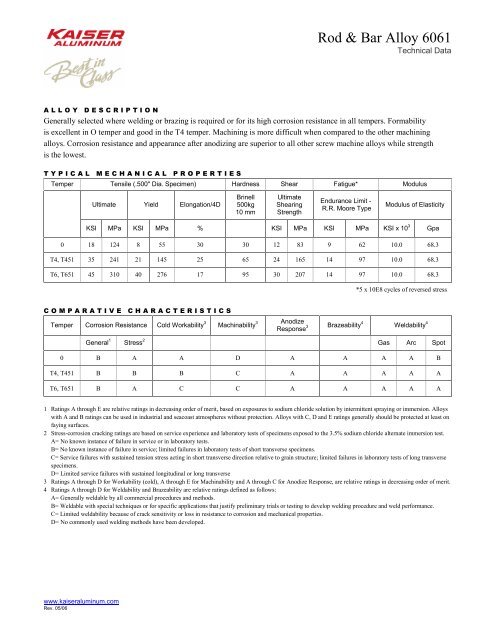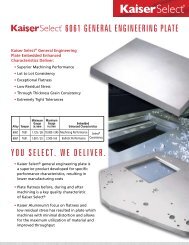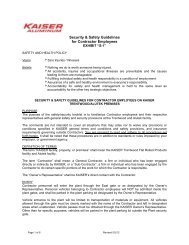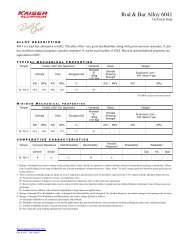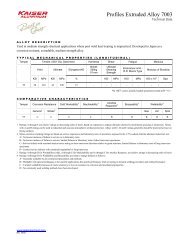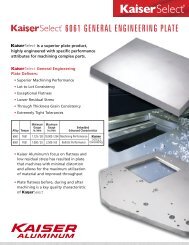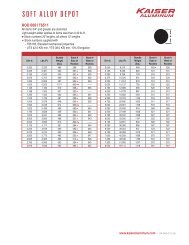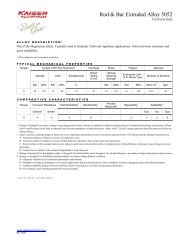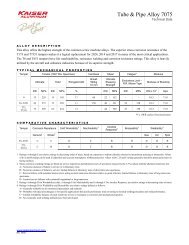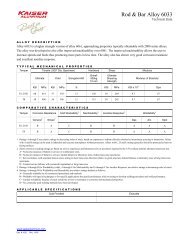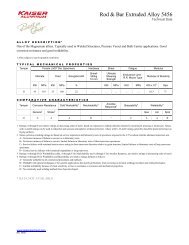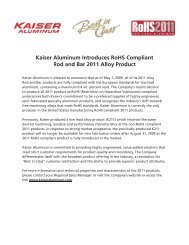Rod & Bar Alloy 6061 - Kaiser Aluminum
Rod & Bar Alloy 6061 - Kaiser Aluminum
Rod & Bar Alloy 6061 - Kaiser Aluminum
You also want an ePaper? Increase the reach of your titles
YUMPU automatically turns print PDFs into web optimized ePapers that Google loves.
<strong>Rod</strong> & <strong>Bar</strong> <strong>Alloy</strong> <strong>6061</strong><br />
Technical Data<br />
A L L O Y D E S C R I P T I O N<br />
Generally selected where welding or brazing is required or for its high corrosion resistance in all tempers. Formability<br />
is excellent in O temper and good in the T4 temper. Machining is more difficult when compared to the other machining<br />
alloys. Corrosion resistance and appearance after anodizing are superior to all other screw machine alloys while strength<br />
is the lowest.<br />
T Y P I C A L M E C H A N I C A L P R O P E R T I E S<br />
Temper Tensile (.500" Dia. Specimen) Hardness Shear Fatigue* Modulus<br />
Ultimate Yield Elongation/4D<br />
Brinell<br />
500kg<br />
10 mm<br />
Ultimate<br />
Shearing<br />
Strength<br />
Endurance Limit -<br />
R.R. Moore Type<br />
Modulus of Elasticity<br />
KSI MPa KSI MPa % KSI MPa KSI MPa KSI x 10 3 Gpa<br />
0 18 124 8 55 30 30 12 83 9 62 10.0 68.3<br />
T4, T451 35 241 21 145 25 65 24 165 14 97 10.0 68.3<br />
T6, T651 45 310 40 276 17 95 30 207 14 97 10.0 68.3<br />
*5 x 10E8 cycles of reversed stress<br />
C O M P A R A T I V E C H A R A C T E R I S T I C S<br />
Temper Corrosion Resistance Cold Workability 3 Machinability 3 Anodize<br />
Response 3 Brazeability4 Weldability 4<br />
General 1 Stress 2 Gas Arc Spot<br />
0 B A A D A A A A B<br />
T4, T451 B B B C A A A A A<br />
T6, T651 B A C C A A A A A<br />
1 Ratings A through E are relative ratings in decreasing order of merit, based on exposures to sodium chloride solution by intermittent spraying or immersion. <strong>Alloy</strong>s<br />
with A and B ratings can be used in industrial and seacoast atmospheres without protection. <strong>Alloy</strong>s with C, D and E ratings generally should be protected at least on<br />
faying surfaces.<br />
2 Stress-corrosion cracking ratings are based on service experience and laboratory tests of specimens exposed to the 3.5% sodium chloride alternate immersion test.<br />
A= No known instance of failure in service or in laboratory tests.<br />
B= No known instance of failure in service; limited failures in laboratory tests of short transverse specimens.<br />
C= Service failures with sustained tension stress acting in short transverse direction relative to grain structure; limited failures in laboratory tests of long transverse<br />
specimens.<br />
D= Limited service failures with sustained longitudinal or long transverse<br />
3 Ratings A through D for Workability (cold), A through E for Machinability and A through C for Anodize Response, are relative ratings in decreasing order of merit.<br />
4 Ratings A through D for Weldability and Brazeability are relative ratings defined as follows:<br />
A= Generally weldable by all commercial procedures and methods.<br />
B= Weldable with special techniques or for specific applications that justify preliminary trials or testing to develop welding procedure and weld performance.<br />
C= Limited weldability because of crack sensitivity or loss in resistance to corrosion and mechanical properties.<br />
D= No commonly used welding methods have been developed.<br />
www.kaiseraluminum.com<br />
Rev. 05/06
<strong>Rod</strong> & <strong>Bar</strong> <strong>Alloy</strong> <strong>6061</strong><br />
Technical Data<br />
A P P L I C A B L E S P E C I F I C A T I O N S<br />
Cold Finished<br />
ASTM B211<br />
AMS-QQ-A-225/8<br />
Extruded<br />
ASTM B221<br />
AMS-QQ-A-200/8<br />
Continued Page 2 of 3<br />
AMS 4115 AMS 4150<br />
AMS 4116 AMS 4160<br />
AMS 4117 AMS 4161<br />
AMS 4128 AMS 4172<br />
ASTM B316 AMS 4173<br />
C H E M I C A L C O M P O S I T I O N L I M I T S<br />
Others<br />
Weight % Si Fe Cu Mn Mg Cr Zn Ti Each Total<br />
Minimum 0.40 - 0.15 - 0.8 0.04 - - - -<br />
Maximum 0.8 0.7 0.40 0.15 1.2 0.35 0.25 0.15 0.05 0.15<br />
www.kaiseraluminum.com<br />
Rev. 05/06
<strong>Rod</strong> & <strong>Bar</strong> <strong>Alloy</strong> <strong>6061</strong><br />
Technical Data<br />
Continued Page 3 of 3<br />
T Y P I C A L P H Y S I C A L P R O P E R T I E S<br />
Characteristic English Metric<br />
Nominal Density (68 °F/20 °C) 0.098 lbs./in. 3 2.70 Mg/m 3<br />
Melting Range 1080 °F - 1206 °F 582 °C - 652 °C<br />
Specific Heat (212 °F/100 °C) 0.214 BTU/lb. - °F 896 J/kg - °K<br />
Coefficient of Thermal Expansion<br />
Linear<br />
68 °F-212 °F<br />
20 °C-100 °C<br />
Volumetric<br />
68 °F/20 °C<br />
13.1 micro in./in.-°F 23.6 micro m/m -°K<br />
3.93 x 10 -5 in. 3 /in. 3 -°F 71 x 10 -6 m 3 /m 3 -°K<br />
O Temper 104 BTU/ft. - hr. - °F 180 W/m - °K<br />
Thermal Conductivity (68 °F/20 °C)<br />
T4, T451 89 BTU/ft. - hr. - °F 154 W/m - °K<br />
T6, T651 97 BTU/ft. - hr. - °F 167 W/m - °K<br />
Equal Volume<br />
O Temper<br />
T4,T451<br />
47% IACS<br />
40% IACS<br />
Electrical Conductivity (68 °F/20 °C)<br />
T6, T651 43% IACS<br />
O Temper<br />
155% IACS<br />
Equal Weight<br />
T4,T451<br />
132% IACS<br />
T6, T651 142% IACS<br />
www.kaiseraluminum.com<br />
Rev. 05/06


